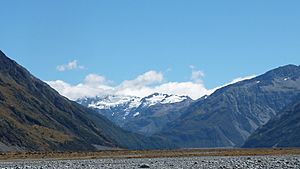Clyde River (New Zealand) facts for kids
Quick facts for kids Clyde River, New Zealand |
|
|---|---|
| Country | New Zealand |
| Physical characteristics | |
| Main source | Frances River and McCoy Stream |
| River mouth | Rangitata River |
| Length | 18 km (11 mi) |
The Clyde River is a cool river found in New Zealand. It's one of the special "braided rivers" you can see in the Canterbury area. Imagine a river that looks like a braid of hair – that's what a braided river is!
Contents
What Makes the Clyde River Special?
The Clyde River starts when two smaller streams, the Frances River and McCoy Stream, join together. This meeting point is called a confluence. From there, the Clyde River flows towards the southwest.
Where Does the Clyde River Go?
As the Clyde River continues its journey, it meets up with two other rivers: the Havelock River and the Lawrence River. When these three rivers combine, they form a much bigger river called the Rangitata River. So, the Clyde River is an important part of a larger river system.
What is a Braided River?
Braided rivers are unique because they don't flow in just one channel. Instead, their water splits into many smaller, winding channels. These channels weave in and out around islands of gravel and sand. It looks a lot like a braid! This happens because the river carries a lot of sediment, like rocks and sand, especially after heavy rain or when snow melts.
Why are Braided Rivers Important?
Braided rivers like the Clyde are super important for the environment. They create special habitats for many different kinds of plants and animals. For example, many unique birds, like the black-billed gull and the wrybill, love to nest on the gravel islands in these rivers. These rivers also help to shape the landscape and are a key part of New Zealand's natural beauty.


